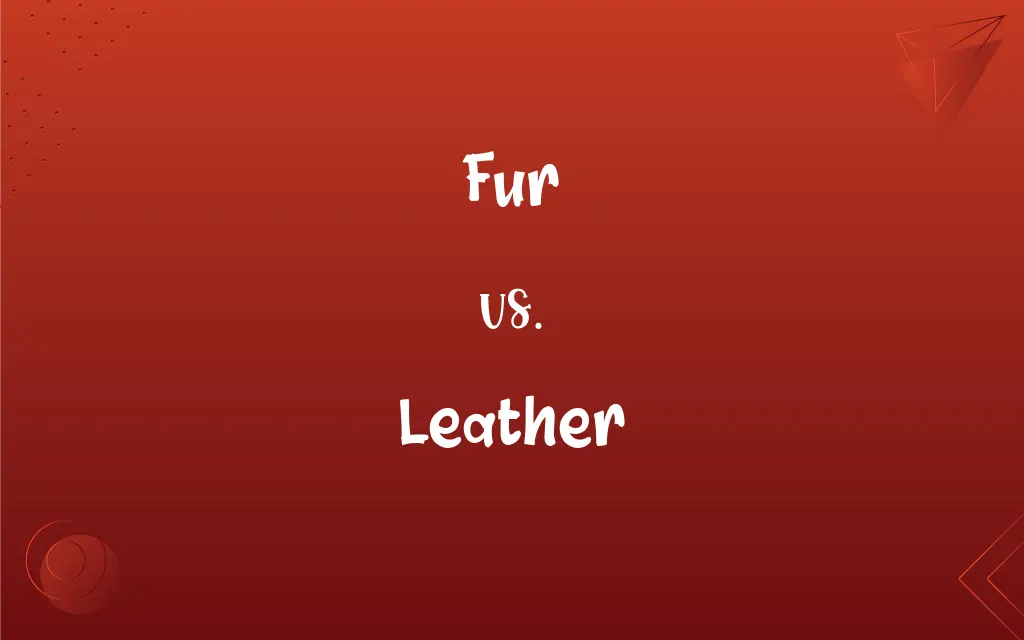Fur vs. Leather: What's the Difference?
Edited by Harlon Moss || By Janet White || Updated on October 7, 2023
Fur is the soft, hairy coat of animals, while leather is the tanned hide or skin, primarily from cattle.

Key Differences
Fur, in its natural essence, is the thick growth of hair covering the skin of animals, primarily mammals. It serves as a protective barrier against environmental elements, ensuring warmth during cold seasons. Leather, on the other hand, is the processed and tanned skin of animals, predominantly from cattle, used widely in crafting products like jackets, bags, and shoes.
The tactile qualities of fur and leather differ profoundly. Fur, by nature, is soft, fluffy, and has insulating properties, making it a choice material for cold-weather garments. Leather, having undergone extensive treatment, is smooth, flexible, and durable, serving as a sturdy material for many goods.
When it comes to sourcing, fur is typically obtained by shearing or skinning animals that possess desirable pelts, such as minks, foxes, and rabbits. Leather production involves removing the hair from animal hides and then subjecting the hides to tanning processes, transforming them into a strong, flexible material.
Ethical concerns surround both fur and leather industries. Fur farming and trapping have garnered criticism for their perceived cruelty and environmental impact. Similarly, the leather industry faces scrutiny over animal welfare, environmental concerns related to tanning, and its carbon footprint.
Alternatives have emerged for both materials. Faux fur, made from synthetic fibers, provides a cruelty-free option mimicking the look and feel of genuine fur. Vegan or synthetic leather offers an alternative to animal-derived leather, crafted from materials like PVC or polyurethane.
ADVERTISEMENT
Comparison Chart
Origin
Hair covering of animals.
Tanned hide or skin, mainly from cattle.
Texture
Soft, fluffy, insulating.
Smooth, flexible, durable.
Primary Uses
Garments, especially for warmth.
Clothing, accessories, upholstery, and more.
Ethical Concerns
Animal welfare in fur farming and trapping.
Animal welfare, environmental concerns from tanning.
Alternatives
Faux fur from synthetic fibers.
Vegan or synthetic leather from materials like PVC or polyurethane.
ADVERTISEMENT
Fur and Leather Definitions
Fur
An animal's coat used in fashion.
The fur coat was luxurious and warm.
Leather
A durable material from animal skin.
She purchased a new leather purse.
Fur
Natural insulation for animals.
The arctic fox's fur protects it from freezing temperatures.
Leather
Tanned animal hide used for crafting.
The leather jacket gave him a rugged appearance.
Fur
A material used in luxury garments.
He gifted her a fur stole for her birthday.
Leather
A popular material in fashion and furniture.
The leather sofa was a centerpiece in their living room.
Fur
The pelts of animals processed for clothing.
The store had a controversial collection of exotic fur.
Leather
The end product of tanning animal hides.
Craftsmen use leather to create hand-stitched wallets.
Fur
The thick coat of soft hair covering the skin of certain mammals.
Leather
The dressed or tanned hide of an animal.
Fur
The hair-covered, dressed pelt of such a mammal, used in making garments and as trimming or decoration.
Leather
Any of various articles or parts made of dressed or tanned hide, such as a boot or strap.
Fur
A garment made of or lined with the dressed pelt of a mammal.
Leather
The flap of a dog's ear.
Fur
See fake fur.
Leather
To cover wholly or in part with the dressed or tanned hide of an animal.
Fur
A furlike coating
Fur on the tongue.
Leather
(Informal) To beat with a strap made of hide.
Fur
To cover, line, or trim with fur.
Leather
Made of, relating to, or resembling dressed or tanned animal hide.
Fur
To cover or coat as if with fur.
Leather
(Slang) Of or relating to the wearing of leather, or patronized by people who wear leather, especially as a sexual fetish
A leather bar.
Fur
To line (a wall or floor) with furring.
Leather
A tough material produced from the skin of animals, by tanning or similar process, used e.g. for clothing.
Fur
The hairy coat of various mammal species, especially when fine, soft and thick.
Leather
A piece of the above used for polishing.
Fur
The hairy skin of an animal processed into clothing for humans.
Leather
(colloquial) A cricket ball or football.
Fur
A pelt used to make, trim or line clothing apparel.
Leather
(plural: leathers) clothing made from the skin of animals, often worn by motorcycle riders.
Fur
A coating, lining resembling fur in function and/or appearance.
Leather
(baseball) A good defensive play
Fur
A thick pile of fabric.
Leather
(boxing) A punch.
Fur
The soft, downy covering on the skin of a peach.
Leather
The skin.
Fur
The deposit formed on the interior of boilers and other vessels by hard water.
Leather
Made of leather.
Fur
The layer of epithelial debris on a tongue.
Leather
Referring to one who wears leather clothing (motorcycle jacket, chaps over 501 jeans, boots), especially as a sign of sadomasochistic homosexuality.
Fur
(heraldry) One of several patterns or diapers used as tinctures.
Leather
(transitive) To cover with leather.
Fur
Rabbits and hares, as opposed to partridges and pheasants (called feathers).
Leather
(transitive) To strike forcefully.
Fur
A furry; a member of the furry subculture.
Leather
(transitive) To spank or beat with a leather belt or strap.
Fur
Pubic hair.
Leather
The skin of an animal, or some part of such skin, with the hair removed, and tanned, tawed, or otherwise dressed for use; also, dressed hides, collectively.
Fur
Sexual attractiveness.
Leather
The skin.
Fur
(transitive) To cover with fur or a fur-like coating.
Leather
To beat, as with a thong of leather.
Fur
(intransitive) To become covered with fur or a fur-like coating.
Leather
Of, pertaining to or made of leather; consisting of leather; as, a black leather jacket.
Fur
To level a surface by applying furring to it.
Leather
An animal skin made smooth and flexible by removing the hair and then tanning
Fur
Pronunciation spelling of for
Leather
The processed skin of animals, mainly cattle.
The saddle was made of high-quality leather.
Fur
The short, fine, soft hair of certain animals, growing thick on the skin, and distinguished from the hair, which is longer and coarser.
Fur
The skins of certain wild animals with the fur; peltry; as, a cargo of furs.
Fur
Strips of dressed skins with fur, used on garments for warmth or for ornament.
Fur
Articles of clothing made of fur; as, a set of furs for a lady (a collar, tippet, or cape, muff, etc.).
Wrapped up in my furs.
Fur
Any coating considered as resembling fur
Fur
One of several patterns or diapers used as tinctures. There are nine in all, or, according to some writers, only six.
Fur
Of or pertaining to furs; bearing or made of fur; as, a fur cap; the fur trade.
Fur
To line, face, or cover with fur; as, furred robes.
Fur
To cover with morbid matter, as the tongue.
Fur
To nail small strips of board or larger scantling upon, in order to make a level surface for lathing or boarding, or to provide for a space or interval back of the plastered or boarded surface, as inside an outer wall, by way of protection against damp.
Fur
The dressed hairy coat of a mammal
Fur
Dense coat of fine silky hairs on mammals (e.g., cat or seal or weasel)
Fur
A garment made of fur
Fur
The thick growth of hair on some animals.
She admired the soft fur of the rabbit.
FAQs
How is leather produced?
Leather is made by tanning animal hides, primarily from cattle.
What is fur commonly used for?
Fur is mainly used for garments due to its warmth and luxurious feel.
Which is more durable, fur or leather?
Leather is typically more durable and long-lasting than fur.
Is fur warmer than leather?
Yes, fur's insulating properties generally make it warmer than leather.
Is leather waterproof?
Leather can be treated to be water-resistant, but it's not naturally waterproof.
Why is leather popular in fashion?
Due to its durability, flexibility, and timeless appeal.
Are there cruelty-free alternatives to both materials?
Yes, there's faux fur for fur, and vegan or synthetic leather for leather.
Is faux fur similar to real fur?
Faux fur mimics the look and feel of real fur but is made from synthetic materials.
Can fur be dyed different colors?
Yes, fur can be dyed, similar to hair or textiles.
Why is fur controversial in fashion?
Due to concerns about animal welfare and the methods of obtaining it.
What types of animals are common sources for fur?
Animals like minks, foxes, rabbits, and chinchillas are commonly farmed for their fur.
Which is more expensive, fur or leather?
It varies, but genuine fur is often more expensive due to its luxurious association.
Are fur and leather sustainable?
Both have environmental concerns, but there are sustainable practices in sourcing and production.
Why is leather preferred for shoes?
Leather's durability, flexibility, and breathability make it ideal for footwear.
How can one maintain the quality of fur garments?
Store in cool, dry places, avoid direct sunlight, and have it professionally cleaned.
Can fur be used for upholstery like leather?
While leather is common for upholstery, fur is less so but can be used for decorative elements.
Do both fur and leather require special care?
Yes, both materials require specific care methods to maintain their quality and longevity.
Can fur and leather get damaged in rain?
Prolonged exposure to water can damage both materials, so protection is advised.
Can leather be recycled?
Leather can be repurposed or upcycled, but its biodegradation is slow.
Are there eco-friendly tanning methods for leather?
Yes, vegetable tanning is an eco-friendly alternative to chrome tanning.
About Author
Written by
Janet WhiteJanet White has been an esteemed writer and blogger for Difference Wiki. Holding a Master's degree in Science and Medical Journalism from the prestigious Boston University, she has consistently demonstrated her expertise and passion for her field. When she's not immersed in her work, Janet relishes her time exercising, delving into a good book, and cherishing moments with friends and family.
Edited by
Harlon MossHarlon is a seasoned quality moderator and accomplished content writer for Difference Wiki. An alumnus of the prestigious University of California, he earned his degree in Computer Science. Leveraging his academic background, Harlon brings a meticulous and informed perspective to his work, ensuring content accuracy and excellence.































































